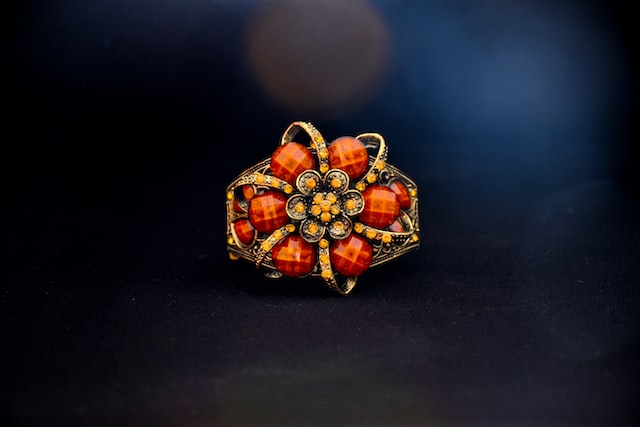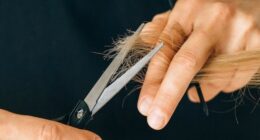A brooch is a decorative piece of jewellery while a pin is a small, thin piece of metal. A brooch is typically larger and more ornate, while a pin is smaller and more delicate.
What is a brooch?
(Photo by Abigail H. on Unsplash )

A brooch is a decorative jewelry piece that is typically worn on clothing as an accessory. It is a decorative pin or clasp that attaches to garments, such as shirts, dresses, or coats, to add a touch of adornment or to hold fabric in place. Brooches come in various designs, shapes, and sizes, and are often embellished with gemstones, enamel, or intricate metalwork. They can be worn for both decorative and functional purposes, serving as a fashion statement or a way to secure clothing in a stylish manner.
What is a pin?
(Photo by Abigail H. on Unsplash )

A pin is a slender, pointed object typically made of metal, often with a sharp end and a rounded or flat head. It is commonly used for fastening or securing items together. Pins come in various forms and serve different purposes.
Straight Pin: A straight pin, also known as a sewing pin, is a thin metal pin with a sharp point and a head at the opposite end. It is commonly used in sewing and crafts to hold fabric pieces together temporarily before stitching.
Safety Pin: A safety pin is a type of pin with a coiled wire and a clasp at one end. It is designed to fasten clothing or hold fabric layers together securely. Safety pins are also used for various purposes, such as attaching tags, organizing keys, or temporarily fixing items.
Lapel Pin: A lapel pin is a small decorative pin worn on the lapel of a jacket, coat, or other garments. It often features symbols, logos, or designs representing organizations, causes, achievements, or personal preferences. Lapel pins are used as accessories or as a means of identification or expression.
Hat Pin: A hat pin is a long decorative pin with a pointed end and a decorative head. It is traditionally used to secure hats to the hair or head, preventing them from falling or shifting. Hat pins were popular accessories in the past but are less commonly used today.
Push Pin/Tack: A push pin or tack is a short pin with a sharp point and a larger, flat head. It is commonly used for attaching papers, notes, or photos to a bulletin board, wall, or other surfaces.
Pins are versatile objects with various applications, ranging from practical uses like securing fabric or attaching items to decorative purposes, allowing individuals to express their style or affiliation.
Brooch Vs. Pin – Key differences
Brooch and pin are both jewelry accessories, but they have distinct characteristics that set them apart. Here are the key differences between brooches and pins:
Design and Purpose: Brooches are typically larger and more decorative in design compared to pins. They are intended to be a statement piece and are often worn for their aesthetic appeal, adding flair and elegance to an outfit. Pins, on the other hand, are generally smaller and simpler in design. They serve a more practical purpose, such as fastening clothing or attaching items.
Attachment Method: Brooches usually have a more elaborate attachment mechanism, such as a clasp or a pinback, which allows them to be securely affixed to clothing or accessories. This attachment method is often designed to be visible or part of the overall decorative element. Pins, on the other hand, typically have a simpler attachment mechanism, such as a straight pin or a tack, which may be hidden or less prominent.
Versatility: Brooches are versatile accessories that can be worn on various clothing items, including lapels, collars, scarves, hats, or even as hair accessories. They can be used to adorn a wide range of outfits, from casual to formal attire. Pins, due to their smaller size and simpler design, are more commonly used for specific purposes, such as attaching name badges, securing fabric layers, or displaying small decorative accents.
Decorative Elements: Brooches are often embellished with various decorative elements, such as gemstones, enamel, pearls, or intricate metalwork. They are designed to be visually striking and may feature elaborate designs, motifs, or patterns. Pins, while they can also have decorative elements, are typically simpler in design and may have a more utilitarian appearance.
Occasions: Brooches are commonly associated with formal or special occasions, where they can complement elegant attire or serve as a focal point of an ensemble. They are often worn for events such as weddings, parties, or red-carpet affairs. Pins, due to their practical nature, are more commonly worn in everyday situations or specific professional settings.
While brooches and pins share similarities as jewelry accessories, the key differences lie in their design, attachment method, purpose, versatility, and the occasions they are typically worn for. Understanding these distinctions can help individuals choose the appropriate accessory for their desired style or functional needs.
How are pins and brooches made?
Pins and brooches are typically made through a combination of design, metalworking, and decorative techniques. The specific manufacturing process may vary depending on the materials used and the desired design, but here is a general overview of how pins and brooches are made:
Designing: The creation of a pin or brooch starts with the design phase. A designer sketches or digitally creates the desired shape, pattern, or motif for the piece. The design may incorporate gemstones, enamel, or other decorative elements.
Metalworking: Once the design is finalized, the production process begins with metalworking. The chosen metal, such as gold, silver, or base metals, is formed into a flat sheet or wire.
Cutting: The metal sheet is cut into the desired shape of the pin or brooch using techniques like sawing, laser cutting, or stamping. Intricate designs may be hand-cut by skilled artisans.
Shaping: The metal components are shaped and formed using specialized tools or machinery. This includes bending, folding, or soldering to create the desired contours and structure of the pin or brooch.
Attachment: Pins and brooches typically include a fastening mechanism, such as a pinback or a clasp, which allows them to be securely attached to clothing. These fastening components are affixed to the back of the metal piece, ensuring proper functionality.
Surface Finishing: The metal surface is treated and finished to achieve the desired texture and appearance. This may involve processes such as polishing, buffing, or applying various finishes like matte, brushed, or high-gloss.
Decoration: If the design calls for additional decorative elements, such as gemstones or enamel, these are added at this stage. Gemstones may be set using techniques like prong setting or bezel setting, while enamel may be applied using techniques like cloisonné or champlevé.
Quality Control: The finished pins and brooches undergo thorough quality control checks to ensure they meet the desired standards of craftsmanship, durability, and aesthetics. Any necessary adjustments or refinements are made at this stage.
Packaging and Distribution: Once the pins and brooches pass quality control, they are packaged and prepared for distribution. They may be sold directly by the manufacturer or distributed through retailers, boutiques, or online platforms.
The manufacturing process of pins and brooches involves a combination of traditional craftsmanship and modern techniques to create unique and beautiful pieces of jewelry. Skilled artisans, designers, and technicians work together to bring the designs to life, resulting in the final products that can be worn and appreciated as accessories.
How to wear a brooch or pin?
Wearing a brooch or pin is a stylish way to accessorize your outfits and add a touch of personal flair. Here are some tips on how to wear a brooch or pin:
Placement: Brooches and pins can be worn in various locations on your clothing or accessories. Common placements include the lapel of a blazer or coat, the collar of a shirt or dress, the pocket of a jacket, or on a scarf. You can also experiment with unconventional placements such as on a hat, handbag, or even as a hair accessory.
Centered or Off-Center: Depending on your preference and the design of the brooch or pin, you can choose to wear it centered or slightly off-center. This adds visual interest and allows you to play with asymmetry.
Style Coordination: Consider the overall style and theme of your outfit when choosing a brooch or pin. Opt for a design that complements the colors, patterns, and textures of your clothing. For example, a floral brooch can enhance a springtime dress, while a vintage-inspired pin can complement retro-style attire.
Secure Attachment: Ensure that the brooch or pin is securely attached to your clothing to prevent it from falling off or becoming loose throughout the day. If the brooch or pin has a clasp, fasten it tightly. If it uses a straight pin, insert it through the fabric and secure it at the back.
Versatility: Don’t limit yourself to just clothing. Brooches and pins can be worn on various accessories as well. Pin them on handbags, backpacks, hats, scarves, or even as an accent on a belt or headband. This allows you to showcase your personal style in different ways.
Layering: Experiment with layering multiple brooches or pins to create a unique and eye-catching look. You can cluster them together or wear them in a vertical or diagonal arrangement. Mixing and matching different designs and sizes can create an interesting visual effect.
Occasion Considerations: Take into account the formality of the occasion when choosing a brooch or pin. For formal events, select an elegant and sophisticated design. For casual or everyday wear, you can opt for more playful or whimsical styles.
Remember, wearing a brooch or pin is an opportunity to express your personal style and add a touch of individuality to your outfits. Have fun experimenting with different placements, styles, and combinations to create looks that reflect your unique personality.
Featured Image By – Atikah Akhtar on Unsplash








